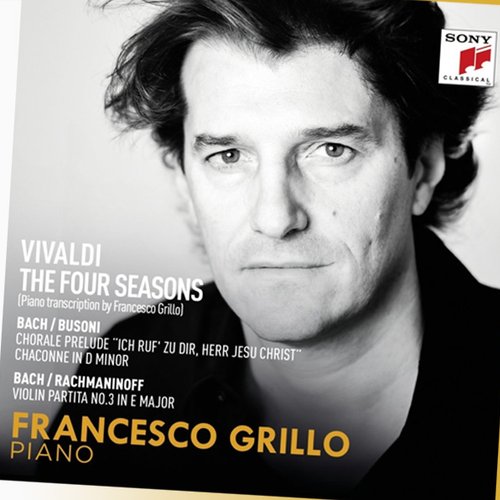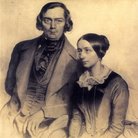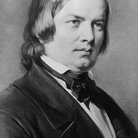Robert Schumann: Violin Concerto - how a séance uncovered a lost classic
The mysterious story of the discovery of Schumann's only violin concerto.
In March 1933, Baron Erik Kule Palmstierna – Sweden’s ambassador to London and an avid psychic researcher – was hosting a séance with his intimate circle of friends. Among them were two flamboyant violinists: the succulently-named Jelly d’Arányi and her sister, Adila Fachiri, great-nieces of the legendary Hungarian violinist Joseph Joachim.
Adila was Baron Palmstierna’s medium of choice. She communicated with the departed using an ouija board with a glass as a pointer. It was placed in the centre of the table and very lightly touched by her and a couple of the other participants.
On this particular occasion, as the glass began to move, the disembodied scribe told the gathering he wanted Jelly to find and play his unpublished violin concerto. They asked his name. The reply? Robert Schumann.
Two weeks later, the group received another mysterious communication, directing them towards the noted music scholar, Sir Donald Francis Tovey. He had seen the work mentioned in Joachim’s biography – a Violin Concerto that had remained hidden away and mostly unheard of for eight decades.
Schumann wrote the Concerto for Joachim between 11 September and 3 October 1853. By then the mentally disturbed composer was suffering serious delusions, saying the spirits of Schubert and Mendelssohn were dictating music to him. After Schumann’s death in 1856, Joachim told the composer’s wife Clara that the Violin Concerto was the inferior product of an unstable mind. It possessed 'a certain exhaustion,' the violinist wrote, 'which attempts to wring out the last resources of spiritual energy'.
With Clara's blessing, Joachim refused to publicly perform the work and kept a tight rein on it for the rest of his life. After his death, the manuscript was sold by his son to the Prussian State Library in Berlin. Joachim had stated in his will that the Concerto should be neither played nor published until 100 years after Schumann’s death.
At a further séance, when Joachim’s great-nieces received contact from their illustrious ancestor, he told them the piece was in the Hochschule Museum in Berlin. They wrote to the museum but received no reply. Schumann's ghost later communicated to them that the man to whom they had written was on holiday!
Another psychic message urged them to write to Baron Palmstierna, then in Sweden, and ask him to seek the work in Berlin on his return. At the Hochschule, the Baron was shown a folder labelled 'Schumann' but it contained only works by other composers. A visitor, however, overheard his enquiries and advised him to visit the archives in the Prussian State Library. There, a reluctant official showed the Baron a file which contained the concerto with Joachim’s name on the label. Although the manuscript seen by Palmstierna was marked ‘unfinished’, Schumann’s ghost was adamant at subsequent séances that the work was complete, 'though it might need some arranging'.
Thrilled at the discovery, Jelly d’Arányi claimed the right of first performance on the basis of the psychic interventions that she said had guided her to it. But the Nazi government intervened - they were on the look out for a new German violin concerto to replace the Mendelssohn which, because of the composer’s Jewish roots, now no longer officially existed. Rejecting the 100-year no-play rule slapped on the Concerto by Joachim, they insisted that a German must give the first a performance. The violinist Georg Kulenkampff played it in front of Goebbels on 26 November 1937 with the Berlin Philharmonic, and recorded it soon after the première. The young Yehudi Menuhin gave the second performance – in a violin and piano version – at Carnegie Hall on 6 December 1937 and Jelly d'Aranyi had to be satisfied with giving the first London performance.
It was not an overnight success. Critics initially agreed with Joachim’s opinion of the work - the New York Times described it as 'very weak' showing 'a failing inspiration and lack of strength.' A British commentator said, 'Of this dismal fiasco, the less said the better.'
Today, the Concerto has firmly become part of the mainstream of the violin repertoire and is considered an important late Schumann work. Menuhin hailed it as the 'missing link' between Beethoven and Brahms, with the 'same human warmth, caressing softness, bold manly rhythms, the same lovely arabesque treatment of the violin, the same rich and noble themes and harmonies'.
Naturally the authenticity of the ghostly messages that led to the Concerto's discovery has been called into question many times over the years. It is possible that the violinist and her medium sister may have been aware that the Concerto's first movement had actually been performed three years before their famous séance. Being young women at the time of Joachim’s death, they could also have been well aware of the provisions of his will, asking for the work to be kept under lock and key for 100 years.
Whatever the truth, Jelly d’Arányi and Baron Palmstierna’s version of events in uncovering this important concerto certainly contributed an added degree of mystery to its emergence from obscurity.









